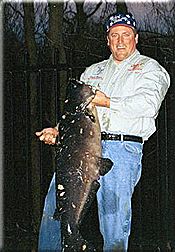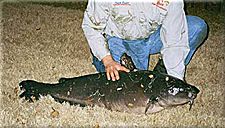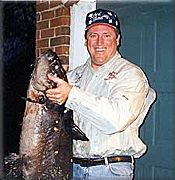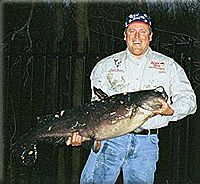
Mother Nature sometimes works in mysterious ways, and one of those ways showed up recently in one of those life experiences that I was blessed to be a part of.
I was fishing on a private one-acre pond that I have nicknamed "The Laboratory." The "Lab" is unique because it is small yet is fed by a spring that is reported to have been there for over 100 years. It's infested with a few massive bass, and its true beauty lies in the fact that many days the water is crystal clear, and it becomes an educational place to watch and learn the habits of large bass. Even better, I have lived there for quite some time, and the shoreline is only 15 feet from my back porch!
On this particular day, my premeditated plan was to position myself on a small walkway over the middle of The Lab. It would give me casting access to the deepest parts and the highest probability of banging a big bass. I hooked up a live bluegill and made a nice long cast. As soon as the gill hit the water, I pushed the line off the reel to ensure there was plenty of slack and that the gill would have the best chance of a natural presentation. I set the rod down, walked a few feet away, and leaned against the walkway rail, watching and waiting.
After a few minutes, I looked over, and the line was moving. I picked up the G.Loomis rod and reeled up the slack; it felt like the gill had been spit out. I sat on the rod for a few seconds, and nothing happened. Reeling up a few turns of the Shimano Calais, it was evident nothing was there. I hit free-spool, placed the rod back down on the walkway, and returned to my leaning post.
Looking back over at the line, it started to move again, yet it wasn't pulling away this time. Instead, it was moving directly opposite to my original cast, backward BACK UNDERNEATH THE WALKWAY! The walkway sits about 15 feet above the water, and I ran over to the rod, watching the line start to rip off the reel. I took the rod and aimed it toward the water to remove any resistance. Something HUGE has just passed below me and the walkway, cutting a large swath in the moss. This was no bass!
The line is ripping off as if I had a Yellow Tail Tuna onboard, yet the line is running underneath the walkway, and I have the pole stretched out in reverse under the walkway as best I can. Finally, it's time to set the hook, and doing a hook-set backward, hanging almost upside down over a rail of the walkway, is something I don't often practice. So with the rod backward, I slam the hook as best I can, and it feels like I have it buried, yet the fish is in control, not me.
Now begins my dilemma. I am 15 feet above the water, and the fish has run under the walkway and is in control. So, I ascertain my options quickly. One . . . I can attempt to reel the fish backward, back under the walkway, even though I now estimate the fish to have ripped off over 100 feet of line. Two . . . I can kick off my shoes and fanny pack and jump into the water to get under the bridge to begin the chase. Unfortunately, the water is way too cold - this is January of all things, and I am up way too high . . . not a good option. Three, I could attempt to find a passerby, pass the 8 1/2 foot G. Loomis rod underneath the walkway to the passerby, then grab it on the other side and start the REAL fight. Yet, this option would nullify a record catch if this turns out to be some large catfish. This is the only viable option for landing this fish, and as I look around for help, there is no one to be found.
Well, when I speak to many audiences across America, sometimes I use an example of when people feel or think they have run out of options when faced with a challenge. So, here it is . . . when a challenge shows up, what options do you have? Take a goal that you have . . . a reachable goal that has a brick wall or challenge in the way of that goal. What are your choices? Well, you have many! You can walk left around the wall, or you can walk around the right side of the wall. You can get a ladder and go over the top. You can dig a hole and burrow right below it. Or, you can find some object and plow through the brick wall to reach the goal. Know this . . . all challenges are usually never limited to one or two options. There are always multiple options for solving most challenges. If you only come up with a few options for any challenge, it's usually based on the "box" in which you have placed yourself.
So, here I am, believing that there is no other choice. Yet, I remember my training. There is another way. What is it? I said to myself . . . "Think outside the box, settle down, figure it out, and you will find the way!" (It's hard to settle down when you have a huge fish tugging on you like a giant Tuna!) I look about 15 feet away from where I had been leaning against the rail, and there sits my other 8 1/2 foot G. Loomis rod. Okay, what if I grab the other rod, use that to reach across the other side of the walkway, and lift the line so I can grab it? Then, if I could grab the line from the other side of the walkway, I could engage my reel, then swing the rod underneath the walkway and grab it on the other side . . . that would work! And that's precisely what I did. I used my other rod and reached it over the other side of the walkway. I used the tip of the pole to bring the line up carefully. I grabbed the line, engaged the spool, swung it underneath the walkway, and caught it on the other side on the first try!!! Yahoo, I'm in!!!!! Plus, I have developed a new "stretch" technique to teach about!
Now I have a chance to land this fish. I run to the end of the walkway alongside the bank and see that the fish is 100 feet away. As I do a double take on the path of the line, it is apparent that the fish is wrapped around an aerator fountain that is positioned in the middle of The Lab. "Great . . . how are we going to get out of this one I ask myself?" I spy down the pole straight to the line to see which side of the fountain the catfish has traveled. I cannot tell . . "Do I go left or do I go right?" It's hard to tell which side of the fountain the line is on! One more look down the straight line, and the fish has swum around the right side. Here is the trick, I need to walk around the perimeter of The Lab (around the right side of the fountain) to get ahead of the fish and clear the obstacle that the fish is wrapped on. The only challenge is that getting around where I need to be will be quite a jaunt!
Now the reverse has to happen. I start pushing the line off the reel as I go back down the bank and to the walkway. I keep a close eye, so there is never too much slack. Over the walkway I go, and to the very end, it's about 200 feet. I get to the furthest corner from where the fish is, and I look down, and there is only about 3-5 feet of line left on the spool. One false move here, and I lose the fish. I turn the corner, continue to walk down the bank, turn another corner, jump over a deck, jump down and around the tree, go down a straightaway, turn another corner, go around another tree and finally get upwind and now in front of the big fish.
I position myself on the bank and am now on the other side of the fountain. I reel down all the slack and pour some heat on the fish. It's caught on the fountain . . . As I crank down on the reel, the fountain starts to move toward me. I can still feel the fish pulling back. I take my time, more time, and I refuse to get in a hurry and make a mistake. I lighten up the slack, the fountain moves away, and suddenly, the fish breaks free and starts to run. Well, now I am in control!!!!

This is where the BIG stick and BIG reel pay off. My BIG stick is a medium-heavy salmon rod built for big fish. My BIG reel is that Calais model with ten ball bearings. So I now get to use my tools, and the fish is now in the open water - advantage Chuck!
The fish runs 80-100 feet. I get the head turned and bring the fish back within a few feet of the shore. The fish runs again and again. I slow it down and bring it back again. The fish wraps up on some other structure and, after a few tense minutes, becomes free and runs out again. The fish makes many major 80-100 foot runs, and now the line is starting to make a noise like sandpaper rubbing together as I am reeling. It is apparent that the line is becoming stressed, and it is now time to land this fish.

I get the fish close enough to see it, and it is a catfish. I get it right up to the bank, and this fish is HUGE. I am not about to try to pull it up. For sure, the line will break. I pull the head of the catfish right into the side of the shore and reach down to try to lift it up and out of the water. The fish still has much fight left in it, and it doesn't like this. It attempts to run out again. I say, "no way," and I jump into the water ( I had just kicked off my shoes and fanny pack) and place the fish between my legs. From past experiences with big cats, I know not to try the "lip it" technique (ouch!), so I grab the gills from both sides and lift the cat onto the shore!
Holy cow . . . the catfish is enormous, and first glance leads me to guess sixty pounds or so. I sat down on the ground and gave a big ole' Texas hoot and holler. When I looked up, I noticed that a few people had now assembled around the shoreline and gave a short round of applause. Others walked up to look at the massive giant of a fish.
After securing the fish in a huge 100+ quart cooler, I asked one of the witnesses to help me certify the fish. It measured forty-six inches long, the girth hit a whopping 30 inches (what a pig!), and she hit right at forty-nine pounds even on the certified scale. Not an easy fish to weigh!

I made sure to settle down the fish before releasing it. The fish was so long that I had to bend the tail to make it fit into my tank. After I got my certification forms filled out and signed, the fish was released. When I gently laid it back in the water, it seemed to take a few moments to get its bearings. Then, just as I thought the fish would need some help, its tail made a big splash in the water, and away it went.
After examining the photos and asking a few experts, the fish was determined to be a "Blue Catfish." Therefore, I have submitted the catch and release to the State Of Texas Game and Fish for a State Record from private waters. If certified, it easily tops the existing record of 18.85 pounds caught from a private lake in Danbury, Texas, in 1999.
One other tidbit I'd like to share with you is belief. The very next day, after banging this giant catfish, I arrived home and walked out to the edge of The Lab and saw five young men on the shore, a couple of them fishing and the others watching. I walked up and asked them how the fishing was. One of the bystanders proceeded to exclaim . . . "Oh, the fishing here is pretty slow, and besides, there are no big fish here!" Knowing that in my inside coat pocket, I had a photo of that forty-niner just caught in this same body of water twenty-four hours earlier made me feel a little special. I smiled and said, yes, you're right and walked away. Little does he know about Forty-Niner!
Tale Of The Tape:
Date of Catch: January 21, 2002
Time of Catch: 5:30 p.m. CT
Fight Time: 55 minutes
Weight: 49 pounds on a certified scale
Length: 46 inches
Girth: 30 inches
Location: "The Lab" Dallas, Texas
Bait: Bluegill B Rod: G.Loomis HSR 1025C Salmon Rod
Reel: Shimano Calais
Line: Triple Fish 17-pound camo
Other comments: Fish was entered into North American Fishing Club's 2002 Catch & Release Contest, and Texas State Record for private waters was applied.
Chuck Bauer is a noted Big Bass Specialist who has been recognized many times by various organizations, including Bassin' Magazine, Texas Fish & Game, North American Fisherman Magazine, Outdoor Life, Texas Hunting and Fishing News, The Dallas Morning News, and Texas Outdoor Times Magazine. In addition, Chuck is a Professional Member of the National Speakers Association and is on Pro Staff for Kick-n-Bass.
Chuck also does free fishing seminars in and around the Dallas/Ft. Worth Metroplex.
